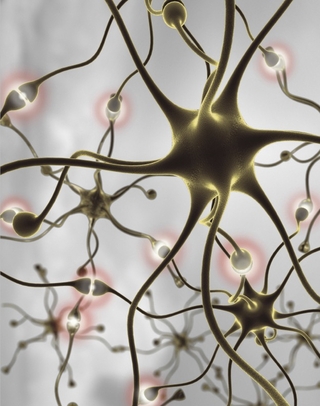Mechanical strip down helps scientists understand nerve cell signals

Rendering of a cell signaling pathway
By Jon Atherton
Our nerve cells transmit signals that process everything from our sense of touch, smell, and hearing, to what makes us feel hungry.
Speed is critical— such as in the millisecond it takes us to register a finger cut — but the timing and strength of nerve signals varies depending on the context.
This variation is vital for how the brain processes information - especially for learning and memory.
When signals between our nerve endings and muscles fall out of sync it can result in disorders like the seizures and muscle tremors associated with conditions like epilepsy.
While nerve cell signaling processes are understood, how variation occurs at the molecular level is less well studied.
Researchers in the lab of Shyam Krishnakumar, an assistant professor of Neurology at Yale, have taken an important step in defining the protein reactions that govern the timing and modulation of nerve signals.
Their findings are published in Nature Communications.
Krishnakumar’s research group, part of the Nanobiology Institute at Yale’s West Campus, focuses on identifying the molecular and mechanistic basis of nerve cell signaling and understanding how this process is altered in neurological disorders.
Led by postdoctoral associate Dipayan Bose, the team conducted in vitro experiments mimicking nerve terminals in cell-free conditions - effectively stripping down neuronal communication to its basic components to identify the small set of proteins regulating the speed and strength of the messaging process.
“This works offers important insight into understanding how individual nerve terminals can dynamically adapt their signaling properties to perform specific functions,” said Krishnakumar.
Uncovering this protein pathway and understanding its functionality is expected to pave the way for developing new therapeutic targets, including gene therapies to address epilepsy and other chronic disorders.
Key contributors were Manindra Bera, research associate at the Yale Nanobiology Institute, and Kirill Volynski at the UCL Queen Square Institute of Neurology in London, UK.